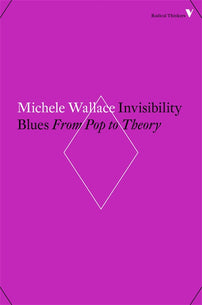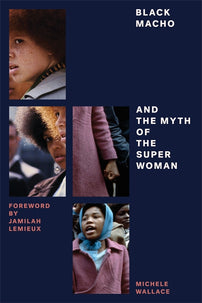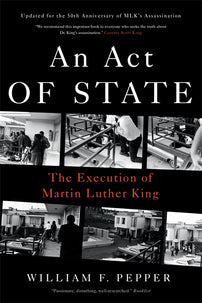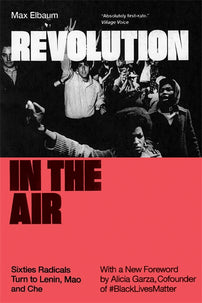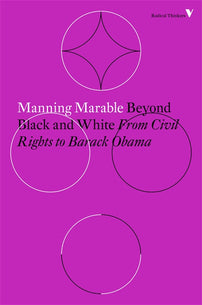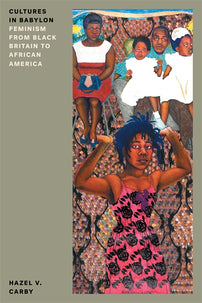Reading 1968: The Great American Whitewash
By ignoring African American intellectual history, many accounts of 1968 consolidate the very segregation 1960s youth were once so determined to undo.

This 1988 essay by Michele Wallace was first published in Zeta magazine and is collected in Invisibility Blues: From Pop to Theory.
After 1968, none of the "other" groups in struggle — neither women nor racial "minorities" nor sexual "minorities" nor the handicapped nor the "ecologists" (those who refused the acceptance, unquestioningly, of the imperatives of increased global production) — would ever again accept the legitimacy of "waiting" upon some other revolution. — Immanuel Wallerstein, "1968, Revolution in the World System: Theses and Queries," 1988
We must become more radically historical than is envisioned by the Marxist tradition. By becoming more "radically historical" I mean confronting more candidly the myriad of effects and consequences (intended and unintended, conscious and unconscious) of power-laden and conflict-ridden social practice — e.g. the complex confluence of human bodies, traditions and institutions. — Cornel West, "Race and Social Theory: Towards a Genealogical Materialist Analysis," 1987
I recently participating in a conference called "1968 in Global Retrospective," which was built around a twenty-seven-page paper by Immanuel Wallerstein about 1968 as "one of the great formative events in the history of our modern world-system, the kind we call watershed events." My job was to talk about "The Key Role of 'Minority' Revolutions," and to chair a panel on "Representations of 1968: Invention and Use of Symbols," which included 1968 historians Todd Gitlin, David Caute, Jim Hoberman, and James Miller.
Minority Revolutions in a Major Key
As I observe the emerging patterns of codification and interpretation of US and global 1960s history, I am beginning to understand how Afro-American intellectual history, despite the publication of Harold Cruse’s The Crisis of The Negro Intellectual in 1967, and so many other books since then, continues not to exist for most white scholarship and commentary. Therefore, it continues to hold only marginal interest for those who would reflect upon the fate of "minority revolutions." Yet it is Afro-American intellectual reflection and analysis of itself, its relationship to the New Left, and other "minority" revolutions that needs to be considered here. First, because it is precisely the ascendency of the "minor" which most distinguishes the events of a global 1968 "world-historical movement." Second, if one fails to consider the intellectual perspective of the "minor" — in this case the Afro-American perspective or the gay perspective — then theory in conjunction with history helps to consolidate at the level of collective memory the very segregation 1960s youth were once so determined to undo.
Such Afro-Americanists as Cornel West, Manning Marable, Hortense Spillers, Henry Louis Gates, Houston Baker, Hazel Carby, Paula Giddings, and bell hooks have been instrumental in revealing an underlying coherence in Afro-American intellectual and cultural development. Collectively, such efforts begin to reveal the degree to which people of African descent in the US have demonstrated in writing and speaking a historical consciousness generally much more subtle and inclusive than mainstream, official versions, one that connects the world views of Phillis Wheatley, Frederick Douglass, and Frances Harper to Ida B. Wells, W.E.B. Dubois, and Zora Neale Hurston to C.L.R. James, James Baldwin, and Lorraine Hansberry to Stuart Hall, Amiri Baraka, and Toni Morrison.
In 1968, such political figures as Angela Davis, Stokely Carmichael, Martin Luther King, Malcolm X, and Ron Karenga, and such writers as Langston Hughes, Sonia Sanchez, Amiri Baraka, and Harold Cruse, and such performers as Harry Belafonte, Nina Simone, Odetta, and James Brown were crucial to how politically engaged people in the period imagined their goals. Now, in retrospect, the impact and significance of these figures is made to seem light indeed, unless, of course, the project becomes to write a black history of 1968, but then that would still be "minor" and "minority" history, something I do not recommend as a solution.
My intention here is to point out the tendency for "history" in the major sense to corroborate a racist, phallocentric hegemony by always marginalizing, trivializing, and decentring a black subject, even as its specific historical object may involve an apparent focus upon issues of ethnicity or racism or, as in this case, "minority revolutions." Yet this history which focuses upon the "minor" or the "minority" may help to corroborate the same apartheid, the same phallocentric center, while banishing to the margins the context that makes, and continues to make, black subjectivity a problem. If white mainstream historians of the New Left have a problem utilizing histories of the "minor" by black authors, they should address that problem, first, as a crucial step to be taken prior to any meaningful examination of the phenomenon of 1968 and its consequences for the present.
To put it another way, somehow, ultimately, black subjectivity, particularly the subjectivity of black women, always seems irrelevant to any serious academic or political discussion of a "black," "ethnic," or "minority" object. This problem is characteristic of how the production of knowledge is constantly employed in reinforcing intellectual racism. Moreover, this habit of leaving the black subject out always seems to coincide with a preference for global or synthetic or structural views. It should continue no longer.
My role here is to contest the notion of a "world system" as yet another attempt to universalize white male intellectual authority over the "voiceless." However, I don’t for a moment believe that high-minded collections of oral history, which allow "the people to speak for themselves," or autonomous insular black intellectual debate will entirely fill the gap. So long as the paradigm employed is sufficiently oriented toward process rather than structure, I have no objection to the notion of "world systems" in and of themselves, especially since I understand that in this case it carries the more practical purpose of addressing the problem of an increasingly global economic arrangement that stifles substantive change and resistance at the local or the national level, or at the level of a specific issue such as ethnicity, class, or sexuality.
For instance, if you look at the drug problem in black communities in big cities in the US, white it encompasses specific issues of ethnicity, class, and sexuality at both the local and the national level, one can’t properly understand the problem until it is considered in the context of a global political/economic arrangement in which the disadvantage to black citizens of the US is outweighed by the advantages in the global marketplace. I understand that most of the people of color in the world are getting screwed as a function of a world system, so it makes sense that amelioration would propose a global approach at some point.
Moreover, regarding the idea that there may be repetitions and parallels in events around the globe, particularly now that a global communications network, including television, film, and wire services, hooks us all up to the same simultaneous stimulation, I am in complete agreement.
I have, for instance, noticed certain patterns, conscious and unconscious, in contemporary black cultural and intellectual reflections on the limits of 1960s black male political leadership "style," in terms of its failure to recognize or accommodate the question of sexual difference. In black film and literature from the US, England, and Africa, there has developed a conventional feminist critique of inequality within the Black Liberation Movement, a trend toward subverting the male/female gender duality in favour of multiple sexualities, including homosexuality and lesbianism, as well as an increasing focus on the inadequacies of a rigid and inflexible concept of masculinity. Besides the considerable literature that explores such issues (novels, plays and poetry by Ntozake Shange, Alice Walker, Toni Morrison, Toni Cade Bambara, Lucille Clifton, Audre Lorde, along with black male writers Ishmael Reed, Charles Johnson, John Edgar Wideman, and David Bradley), I see Spike Lee’s School Daze (1988), Isaac Julien and Maureen Blackwood’s The Passion of Remembrance (1986), and Sarah Maldoror’s Sambizanga (1972), about the struggle for liberation in Angola, all as films in which there is a related concern about the loss of a unitary concept of "the black (male) leader."
For instance, in School Daze (at a level that is perhaps unconscious to director Spike Lee), Dap’s leadership, and thus his role as protagonist, is constantly questioned and challenged, not only by the college administration, but also by the "women" and by his friends, as well as by the continuous flow of dance, song, style, and sexual spectacle that fights with him for the focus of the film and seems to be saying that this film has more important business to attend to than telling his linear (phallic) narrative.
In Passion of Remembrance, which more candidly embraces a critique of sixties male leadership and its knee-jerk heterosexism, the combination of carnivalesque spectacle, political commentary and archival footage is, finally, much more satisfying than the English film most often lauded for these attributes, Sammy and Rosie Get Laid (1987). While I admire the films of Stephen Frears and Hanif Kureishi, especially My Beautiful Laundrette, their version of Third Worldism seems problematic. It becomes an opportunity for a fashionable kind of cynicism (much like liberalism) about the possibility for fundamental world change, coupled with an explicit but unanalyzed hierarchizing of a literature and prosperous "Third World" (mostly Indian) and an illiterate and impoverished "Third World" (mostly black) in England. From the first scene in Sammy and Rosie, it is blacks who are marginalized in that they occupy the film’s most desperate and precarious social, sexual and economic positions. That these positions are visualized usually in the absence of any verbal explanation only makes it more urgent that they be interrogated.
In Sambizanga, while the critique seems somewhat unconscious on the director’s part, the black male "leader" is both figuratively and literally slain from the beginning of the film. From the scene in which the crying of the men is not visualized, we gather that a point is being made about the revolutions and sexual difference. Rather, it is the film’s focus on the crying of the women and its relationship to cultural continuity that seems to indicate the means by which the struggle will continue.
In real life in the US — if you can call The Morton Downey Show real life — this critique of past black male leadership takes the form of Roy Innis and Al Sharpton’s fistfight at Harlem’s Apollo Theatre, ostensibly over the case of Tawana Brawley. Meanwhile, Brawley is a fifteen-year-old black teenager whose rape is somehow unimaginable and unspeakable to present black political discouse, as the debate rages over whether Sharpton is a "fake." Black male leadership seems no better prepared to fathom the black teenager’s psychological, social, economic, and educational plight now than in 1968. And no better prepared to cast out the Sharptons.
At the same time, we should not dismiss too quickly the inherent dangers that even progressive "world systems" present. This is the danger of neo-colonialism or neo-imperialism in intellectual form, and what makes it so is that mostly only white males are empowered to engage in that discourse. The problem is, as Trinh Minh-ha points out, "they work toward your erasure while urging you to keep your life and ethnic values within the border of your homelands. This is called the policy of 'separate development' in apartheid language."
Somewhere Over the Rainbow
There has never existed heretofore international (that is, interzonal) solidarity of any significance. And this fact has given rise to much bitterness. One, the immediate day-to-day concerns of the populations of the three zones are today in many ways strikingly different. The movements that exist in these three zones reflect their differences. Secondly, many of the short-run objectives of movements in the three zones would, in achieved, have the effect of improving the situation for some persons in that zone at the expense of other persons in other zones. Thirdly, no desirable transformation of the capitalist world economy is possible in the absence of trans-zonal political cooperation by antisystemic movements.
This trans-zonal cooperation would have to be both strategic and tactical. It might be easier (albeit still not easy) to establish the bases of tactical cooperation. But strategic? It is probable that strategic collaboration can only be on the basis of a profound radicalization of objectives. For the great impediment to trans-zonal strategic collaboration is the incredible socio-economic polarization of the existing world system. But is there an objective (and not merely a voluntaristic) basis for such a radicalization? — Immanuel Wallerstein, 1988
I am not concerned to question here the nature of this proposal. Rather, my focus is upon "a profound radicalization of objectives" all but inaccessible through the theorizing of "world systems." This theorizing, after all, in no way subverts or transforms white male academic authority and, therefore, confirms our present unsatisfactory arrangements of cultural hegemony. The only door through which "change" at a critical level can enter is by altering the composition of the community that considers the problems of "objectives." White men in positions of power have to stop thinking that it is their place alone to determine the course of our lives.
I am not proposing that if Wallerstein were black, everything would be fine. I am not a nationalist or a postnationalist, nor does "racial pride" make a lot of sense to me as a political goal (although I guess I have my fair share). Rather, I am proposing that if the experiences of race, ethnicity, gender, and sexuality were made central to future considerations of "world systems," the process would be a lot more convincing in terms of locating a "profound radicalization of objectives." Moreover, this blind spot on ethnicity and sexuality transcends the problem of "minorities" as "women and blacks," who are not, after all, global minorities, but who are simply minor in the sphere of knowledge production. Not only is there a failure to consider the question of world systems or global perspectives from the view of the racial or sexual "other." There is also a failure to consider the other that may ultimately be at the center of even a so-called majority white male existence, the other of ethnicity, religion, sexuality, rationality (which he repetitively banishes), the other of homelessness, both geographical and existential, which may be the driving force behind this compulsive white male Western insistence upon authority and dominance.
So the question for me is not even whether or not Wallerstein is right or wrong. Such a question cannot be addressed until we have contended with the discrepancy in that perspective itself, the view from which the history of 1968 is first recollected that obliterates the possibility of black subjectivity, not only in the US but in the Caribbean and Africa as well.
Perhaps the clearest occasion upon which this occurs is in Wallerstein’s Thesis 4: "Counterculture was part of the revolutionary euphoria, but it was not politically central to 1968." The subsequent explanation of this thesis goes on to define the "counterculture" in a way that not only precludes its historical relationship to Afro-American culture, but also renders 1960s Afro-American social and political life, including the Civil Rights Movement and Black Power, entirely invisible. Afro-American cultural production then becomes an incidental and minor aspect of US and European counterculture or, in this case, a nonentity. The historical relationship is first reversed: counterculture no longer comes out of Afro-American culture but rather the other way around. Rock ‘n’ roll’s roots in an Afro-American blues tradition are not acknowledged. The beat aesthetic is no longer influenced by the lifestyles and performances of black jazz musicians. And American youth culture bears no relationship whatsoever to black street culture.
Then, in the most preemptive move, the one that makes history irrecoverable by transforming it into myth, the counterculture is defined as that which is gratuitous, that which belongs to no one, which is not culture at all, but counter-to-culture or against culture. "We generally mean counterculture," Wallerstein writes, "behavior in daily life (sexuality, drugs, dress) and in the arts that is unconventional, non-'bourgeois,' and Dionysiac." There is never any doubt in this statement that there is a more useful, mainstream, conventional, bourgeois, and Apollonian culture that will counteract the countercultural. The countercultural is then perceived as entirely peripheral to profound change. Still, I would like to claim this degraded form of culture as the true location for a revolutionary potential in Afro-American social life.
Afro-American culture has long been the starting point for white self-criticism in the US. Mid-twentieth-century white and black youths were impressed by the resilience and versatility of Afro-American culture: its working mothers employed as domestics with husbands or men who could not find work; its poor elderly black men who had labored for a pittance all their lives yet could not invent songs of indescribable beauty in which they accurately weighed the material and psychological complexity of their world; its traditions of music, which seemed to turn the hypocrisy of conventional Protestantism inside out; its church-going people who would lay their bodies down before waterhoses, dogs, and white Southern racism and then get up and fight for the Mississippi Freedom Party and against US military involvement in the Vietnam War.
The realization that such people existed despite the efforts of a white, racist ruling class to destroy their dignity and appropriate their vitality was a crucial influence on the widespread conviction in 1968 that US dominance and world hegemony were unconscionable and parasitic, and that the "Old Left" lacked the sensitivity to grapple with real people in a real world of cultural diversity. Afro-American culture was instrumental in forming the aspirations of the New Left, as well as minority revolutions — not so much by its considerable political activity, but precisely by its counterculture. While this "minor" culture may sometimes be difficult to link directly to political protest, it was always clearly formed in the spirit of subverting a majority culture that tried to choke it to the root. Precisely in its sex, drugs, dance, music, and style, it kept the record of its discontents accurately and well. Perhaps this counterculture is the site where mainstream culture is still most forcefully challenged, even as "revolutions" come and go.
Like everything else human, there are many countercultures, not just one. For instance, today, black youth resist total white hegemonic control over everyday life, often by means considered counter to culture, by drug use and the life of the streets, by their unwillingness to go to school and their inclination to have babies. While such developments are largely the result of an economic and education stagnation imposed upon them from above, black teenagers respond to this situation partly in the form of an interpretation (from drug use to pregnancy to rap) that is connected, by influence and osmosis, to countercultural developments, white, black and brown, in the 50s and 60s.
As for those decades, I am certain of a deliberate and self-conscious black counterculture because my parents — my father, who was a jazz musician, my mother, who was an artist, and my stepfather, who was their close friend — were part of it in the 50s. In the 1960s, my father, divorced from my mother and an unsuccessful musician, would die of a heroin overdose. In 1965, the summer he died, my mother, my sister and I took classes at Amiri Baraka’s (then Leroi Jones) newly inaugurated School of Black Arts in Harlem. A public high school teacher who was moonlighting as an artist, my mother Faith became a 1960s radical, taking an active role in the black struggle against the United Federation of Teachers over "decentralization" of the public schools.
In those years, the hardest thing to figure out was culture, how our everyday lives would bear the mark of our political commitment, for it was immediately clear to everyone, once the Civil Rights and Voting Rights bills has been settled, that US capitalist hegemony undermined you most at the level of the everyday. In 1963, Faith began to produce a series of paintings called "American People," in which she tried to capture the drama and the underlying structure of the racism that the Civil Rights Movement confronted, as we then viewed it on our television screens, as it affected race relations in the North, as it was written about by James Baldwin in The Fire Next Time (1963) and Amiri Baraka in Dutchman (1964). In 1970, when I became a student at the City College of New York, I was already struck by how many politically active black students were getting involved in heavy drug use, dying at a hospital across the street.
1968 Revisited
"Where is tomorrow’s avant-garde in art and entertainment to take on the racial bias of the snowblind, the sexual politics of the frigid, and the class anxieties of the perennially upper crust?" When I asked this question a few months ago, I was trying to make light of something that is not light at all. As ridiculous as it may seem, a white cultural avant-garde, here and abroad, has always believed it possible to make an oppositional art without fundamentally challenging hegemonic notions of race, sexuality, and even class.
Of course, when I was a kid, we didn’t call it "white cultural hegemony." We called it the "Great American Whitewash." I had the great good fortune to be raised in a family of artists (my stepfather was not an artist but worked at General Motors to finance our creativity) in which resistance to the old truism, "If you’re white, you’re all right; if you’re brown, stick around; and if you’re black, stay back," was viewed not only as paramount to making art, but basic to one’s psychological survival. I still find it astonishing when white people consistently conceptualize resistance in ways that minimize the importance of race, or the vital contribution black artists and intellectuals have made to the discussion of that issue.
But I was first struck by the true dimensions of this problem in 1970, when Faith and I attended a guerrilla art action protest against Art Strike, which was itself a protest against "racism, war and repression." A group of famous white male artists led by Robert Morris decided to withdraw their work from the Venice Biennale, a prestigious international exhibition, in order to protest US bombing of Cambodia and the murder of college students at Kent, Jackson, and Augusta. Although the protest was supposed to be against "Racism, War, and Repression" (sexism was not yet on their agenda), Art Strike then expected to mount a counter-Biennale in New York without altering the all-white male composition of the show. This seems to be the key to understanding the intrinsic limits of Western cultural avant-gardism: while it can no longer deny its own white male supremacist presuppositions, it cannot be rid of them either.
In the first years of our feminism, working through an organization that we founded called Women Students and Artists for Black Art Liberation (WSABAL), Faith and others succeeded in opening this exhibition to women and people of color. WSABAL was also influential in the subsequent development of Ad Hoc Women Artists, led by Lucy Lippard. This group repeated WSABAL’s 50 per cent women demand in their protest against the Whitney Biennial, which was in the habit of including white male artists almost exclusively. Specifically because of Faith’s research and support of Ad Hoc, black women artists Barbara Chase Riboud and Bettye Saar were included in the next Whitney Biennial.
Of course, Faith’s activism against the museum had not begun in 1970. It really began in 1968, the year of Martin Luther King’s assassination, when every black artist and cultural worker in the country was galvanized into action. Only sixteen years old at the time, I accompanied Faith to the first demonstration of black artists against the Whitney Museum and then to a series of free-for-all (Art Workers’ Coalition) demonstrations against the Museum of Modern Art. The museums were still reluctant to call in the police at that point. Yet, since the Civil Rights Movement, Black Power, and the riots, it was no longer tolerable simply to "picket" in an orderly fashion. These demonstrations were increasingly unpredictable, full of street theatre and creative mayhem, very countercultural in the Wallerstein/Dionysiac sense.
In one case, I can remember museum administrators and security guards standing helplessly by as Faith led a walking tour through MoMA’s first-floor galleries during which she lectured on the influence of African art and the art of the African Diaspora on the so-called modern art displayed there. The manner in which academic and critical expertise and the museum’s curatorial staff conspired to render the importance of that influence either invisible, trivial, or merely instrumental shaped her remarks. When we finally came to a room in which the works of a black artist were displayed — perhaps two or three gouaches from Jacob Lawrence’s 1930s "Black Migration Series" — Faith designated it the location for the Martin Luther King Wing, which was then the principal demand of the Art Workers’ Coalition demonstrations at MoMA. This wing was supposed to serve as an exhibition space that would revolve around a cultural education center and would train blacks, Puerto Ricans, and Native Americans in art history and museum administration. This cultural education center would lead to the canonization of some black artists and the hiring of a few non-white curators, but its main intention was to promote an increase in the number of young people of color who would be drawn to careers in art and art education, to foster a more meaningful relationship to museums and "high culture" for the throngs of non-white public school children who were obliged to visit museums every year.
For many, the Civil Rights Movement was their first exposure to the power of Rainbow Coalitions. My first experience came during those years of involvement with the Art Workers’ Coalition. But the lessons were hard ones. Ultimately, there would be no Martin Luther King Wing, no cultural center, only retrospective exhibitions for black artists Romare Bearden and Richard Hunt, which made them (no doubt because they were men) even more famous than Barbara Chase Riboud and Betye Saar.
The resulting tokenism of a few museums shows for a few black artists did not really change the embedded elitism of the art world. Visual art is still perceived by many as the exclusive entertainment of the rich, as though the rest of us didn’t need something to look at. At the same time, the important thing seemed to be that my mother was an activist whose work as an artist was consistent with her politics, although I pointedly failed to mention any such thing in my own recollection of the 1960s in Black Macho. This was perhaps my greatest and most unfortunate oversight, since her politics were my politics in the 1960s and for much of the 1970s. If you are lucky enough to have a mother who has a forcefully autonomous political vision, it will be a while before you can be expected to come up with any ideas of your own. Of course, I didn’t realize this when I wrote Black Macho at the age of twenty-six. Moreover, it is not the style in commercial publishing to give credit where credit is due. Particularly when the credit is due to your mother who is just as black as you are!
Now, however, as recollections of the 1960s mount up — among others, Todd Gitlin’s The Sixties: Years of Hope, Days of Rage, James Miller’s Democracy Is in the Streets: From Port Huron to the Siege of Chicago, David Caute’s The Year of the Barricades: A Journey Through 1968, Sara Evans’ Personal Politics: The Roots of Women’s Liberation in the Civil Rights Movement and the New Left, George Katsiaficas’ The Imagination of the New Left: A Global Analysis of 1968 and Daring to Be Bad: Radical Feminism in America, 1967-1975 by Alice Echols — we are again facing the Great American Whitewash. Not only has the breadth of the Afro-American cultural presence and contribution almost ceased to exist, but also black, Latino, Asian, feminist, and gay "minorities" have become "minor" again, as though the revisions of the 60s and the 70s in the way we conceptualize "history" had never happened.
This is so despite institutions like the Studio Museum in Harlem, which mounted a 1960s show in 1985 called "Tradition and Conflict: Images of a Turbulent Decade, 1963-1973" that included endless examples of politically engaged art by women and blacks in the 1960s. Besides Faith, the show included black artists who have long done political work like Bettye Saar, Charles White, Louis Mailou Janes, Benny Andrews, Elizabeth Catlett, Romare Bearden, Jacob Lawrence, Viviane Brown, Camille Billops, Dana Chandler, and David Hammonds, together with white political artists like May Stevens, Leon Golub, and Nancy Spero. There were also black artists whose work tends to be less political in explicit content, but whose use of abstract form, design, and medium challenges the conventions of Western art, the elitism of its hook-up with US capitalism, forging a link with African and other non-European visual traditions: such artists were Joe Overstreet (whose more political "New Aunt Jemima" was include), Daniel LaRue Johnson, Vincent Smith, Barbara Chase Riboud, Howardina Pindell, Malcolm Bailey, and Mel Edwards.
The catalogue, a landmark publication still on sale at the Studio Museum in Harlem, includes essays by Vincent Smith, Lucy Lippard, and Mary Schmidt-Campbell. Schmidt-Campbell remarks upon the repeated use of images of the US flag and of Aunt Jemima in the art of Afro-American artists of the 1960s. By that time, Faith had used images of the flag in "God Bless America" and the large mural, "The Flag is Bleeding," which were both part of "The American People" series. She had used the flag again in her "America Black" series in a painting called "Die Nigger Flag for The Moon," which was a parody of the flag that US astronauts planted on the moon in 1969.
In 1971, at the Judson Memorial Church in New York, we helped to organize, along with John Hendricks and Jon Tosh of Guerrilla Art Action, a flag exhibition to protest the Federal law against "desecrating the flag." Faith was arrested as one of the Judson Three for violating this law. Minimal artist Carl Andre taped a strip of flag stamps across the floor for people to walk on. Yvonne Rainer’s troupe tied flags around their necks and danced naked without music. There were these and other wonderful gestures of white avant-garde humor, but what do you suppose would have happened if a black artist had taped a strip of flag stamps across the floor for people to walk on, or a black dance troupe had stripped their clothes off and danced nude with the American flag draped around their necks? Would they have been as readily recorded and applauded? No more than a few of the many artists of color who participated in this exhibition were recorded and applauded. I think the reason for this is racism, knee-jerk, know-nothing, nativist racism among the avant-garde left, the counterculture, and among those who have hitherto written about them.
[book-strip index="1" style="display"]